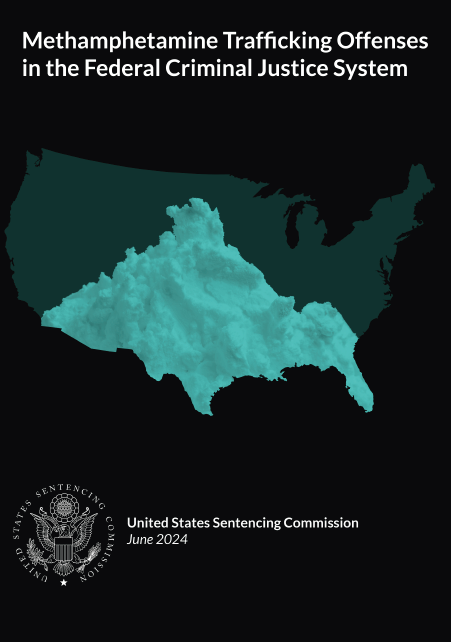Summary

(Published June 13, 2024) This report examines trends in the prevalence of federal methamphetamine trafficking sentences, and the purity levels of methamphetamine trafficked in the United States. The Commission analyzed 20 years of sentencing data and conducted a special data collection project examining the purity of methamphetamine trafficked and offense conduct of individuals sentenced for trafficking methamphetamine in fiscal year 2022. This report is the Commission's first comprehensive analysis of federal methamphetamine trafficking offenses in nearly 25 years. View the related press release.
Key Findings
- Methamphetamine has been the predominant drug in the federal caseload since fiscal year 2014 and comprised approximately one-half (48.7%; n=9,555) of all drug trafficking offenses in fiscal year 2022.
- In fiscal year 2022, individuals sentenced for trafficking methamphetamine received average sentences of 91 months, the longest among all persons sentenced for a federal drug trafficking offense.
- Methamphetamine trafficking was more severely sentenced than crack cocaine (70 months), heroin (66 months), or fentanyl trafficking (65 months).
- Individuals sentenced for trafficking methamphetamine were convicted of an offense carrying a mandatory minimum penalty more often than all other individuals sentenced for drug trafficking (74.2% compared to 56.6%). However, they received relief from mandatory minimum penalties at similar rates (54.7% and 58.4%, respectively).
- Methamphetamine is highly and uniformly pure.
- The methamphetamine tested in fiscal year 2022 was on average over 90 percent pure (93.2%) with a median purity of 98.0 percent.
- The methamphetamine tested in fiscal year 2022 was uniformly highly pure regardless of whether it was sentenced as methamphetamine mixture (91.0% pure on average), methamphetamine actual (92.6%), or Ice (97.6%).
- Because the statutory and guideline penalties for methamphetamine are based in part on purity, sentences imposed are impacted by laboratory testing practices which vary across the nation.
- Individuals sentenced for trafficking methamphetamine mixture received shorter average sentences (83 months) than individuals sentenced for trafficking methamphetamine actual (93 months) or Ice (103 months).
- Laboratory testing to determine purity was performed in three-quarters (75.6%) of the methamphetamine offenses in this study and varied geographically.
- Border districts had higher rates of drug testing (86.4%) compared to non-border districts (71.2%).
- Testing also varied by judicial circuit. More than 85 percent (85.6%) of methamphetamine offenses sentenced in the Ninth Circuit involved laboratory testing, compared to 58.0 percent of methamphetamine offenses sentenced in the Seventh Circuit.
- Sentencing guideline enhancements targeted at domestic methamphetamine production rarely apply, as the production of the drug has shifted outside the United States.
- In fiscal year 2022, only ten individuals received an enhancement related to harm to persons or the environment.
- This study identified only 19 methamphetamine laboratories, used solely to convert liquid methamphetamine into a crystal form.
- Sentencing guideline adjustments related to the individual’s role in the offense have a greater impact in methamphetamine offenses compared to all other drug trafficking offenses.
- A greater percentage of individuals sentenced for methamphetamine trafficking received a mitigating role adjustment under §3B1.2 for having minimal or minor participation in the drug offense (23.5%) compared to those trafficking other drugs (17.0%).
- Nearly thirty percent (27.2%) of individuals who trafficked methamphetamine actual received a mitigating role adjustment, more than individuals who trafficked either methamphetamine mixture (19.7%) or Ice (18.3%).
